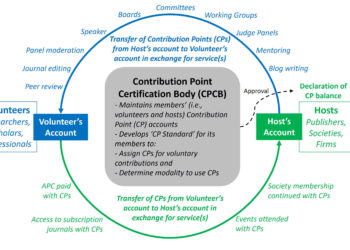
As noted in Joe Esposito’s post yesterday, two weeks ago and on the same day, both the CEO and CFO for the Public Library of Science (PLoS) left the organization. This is such a strange event — I can’t recall any other scientific publisher releasing both people holding these positions at the same time — that both of us have been scratching our heads.
The shake-up has proven to be just as interesting for other reasons.
It’s been difficult to discover exactly why the two main leaders of the organization left simultaneously, but it apparently occurred in a precipitous manner, judging from the blog post announcing the change:
The Board has appointed an interim leadership team effective immediately to ensure that PLOS is able to continue to move projects and strategic initiatives forward. Together with the existing PLOS Executive team, they will govern the organization until Marincola’s arrival.
The members of this “interim leadership team” are not identified.
Elizabeth Marincola is taking the reins in August. Marincola was on the PLoS Board from 2005-2011. In an interesting twist to the appointment, she is currently the Chairman of the Board of Directors for eLife. There is no mention of this entanglement — or its resolution — in the PLoS announcement. In response to an email asking about this, Marincola explained that she will be resigning as Chairman of the Board at eLife in order to take the PLoS CEO position.
When asked for comment, Mark Patterson of eLife responded in a manner I wouldn’t expect from an apparent competitor:
We offer our congratulations to Elizabeth, and look forward to continuing a strong collaborative relationship with PLOS, with Elizabeth at the helm. We’re obviously sorry that Elizabeth is moving on from our board (her formal departure date is to be determined), but delighted to see her take on such a prominent role in the world of open-access publishing.
Patterson was Director of Publishing at PLoS, and seems to seek what one might generously call “collaboration” where others would see natural and even necessary boundaries and required processes — after all, he was the person to request launch assistance from the US government on behalf of Wellcome Trust, was allowed to skip the application process at PubMed Central (PMC), asked NLM staff to comment on eLife editorials, discussed PeerJ’s launch with PeerJ in one hand and PMC in the other in order to shape the proper message to protect eLife’s interests, and either explicitly or tacitly agreed with David Lipman to avoid telling the PMC National Advisory Committee about the work eLife and PMC were doing at that time to use US government resources to expedite eLife’s launch.
In reference to the recent inappropriate relationships between eLife and PubMed Central, it seems worth mentioning that Marincola was also a member of the founding National Advisory Committee for PubMed Central, and was Chairman of the Board of eLife when eLife was seeking special treatment from PubMed Central. Chronologically, here are her most recent stints:
- PubMed Central National Advisory Committee — 2000-2003
- PLoS Board of Directors — 2005-2011
- eLife Chairman of the Board — 2012-2013
- CEO, PLoS — 2013-
Now, Patterson (formerly of PLoS and now at eLife) is looking forward to “collaborating” with PLoS in his position at eLife, as the former chairman of eLife and former founding PMC NAC member and former PLoS Board member takes over as CEO of PLoS. The ladder of intersections is downright vertiginous.
Every small industry has a structural problem based on small numbers, which is often referred to casually as the “incestuous” aspect of the industry. After a decade or so, you tend to know a lot of the people, recognize what may feel like the majority, and maybe after 20 years you will have worked with a small proportion of them, either directly or indirectly.
I heard a story recently of a database in Iceland that has been turned into an app. In Iceland, there aren’t that many people – similar to a small industry, like scientific publishing, let’s say. So, the government created a database of all the family relationships, which has been turned into an app so that if you meet someone who catches your eye, you can both check that you’re not related before you dive deeper into the romantic waves. Now, imagine if someone used this database specifically to date relatives? That would not be a healthy approach to genetic variation and diversity. The swapping and collaboration above certainly seems an effort to stick to family lines. PLoS went outside the industry for the CEO and CFO they just let go, and now have returned to someone they know very well.
But back to the CEO and CFO leaving at the same time, a remarkable event at any organization. Here are scenarios to consider, and the likely personnel changes at the executive level:
- Strategic disagreement — CEO leaves, CFO stays for financial management and continuity
- Leadership incapable of coping with growth — CEO leaves, CFO stays for financial management and continuity
- Financial impropriety — CFO leaves, CEO may stay if unaware or is the one who discovered it, but would go if a participant
- Human resources issue — Hard to imagine both senior executives leaving for these reasons
- CEO and CFO have other plans — The two resign precipitously of their own volition, perhaps to compete with the company they are leaving or simply to pursue a new business venture together
Each of these situations would be easy to message, but PLoS’ board has not even put a fig leaf of an explanation out. That’s also highly unusual.
The only rumor — and I emphasize, this is a rumor only — is that the CEO and CFO argued vigorously that PLoS should either become for-profit, or spin off a for-profit, were shut down by the board, and it ended in tears. This doesn’t quite add up, either, because a board that takes a stand like this would be doing its job, and should be able to offer at least a signal that there was some disagreement between management and governance.
Again, the situation is extraordinary, and how it’s being handled is perplexing.
These jobs were not the kind you leave on a whim, at least based on their compensation levels. Jarram was well-paid, with total compensation in 2011 of more than $543,000. Borostyan was also paid well, with 2011 compensation of more than $330,000. These are good compensation packages, and on par with industry norms. (It seems the OA community’s tendency to decry highly paid executives only lasted until they needed highly paid executives.)
I’ll note once more that it is extremely rare for both a CEO and CFO to leave an organization simultaneously. Aside from being officers of the corporation, the CEO and CFO are meant to form a strong partnership to guide the organization; if one leaves, the other is there to provide continuity. The CFO has been called a “CEO in waiting.” When both leave simultaneously and precipitously, the natural instinct is to think something was very wrong.
While the new CEO has been announced, there is no indication that a new CFO has been identified or will be hired.
I tried to contact Board members at PLoS to get clarification about what exactly went on. Michael Eisen had this to say:
I’m not authorized to comment on this.
All organizations that last long enough and become complex enough have problems. In the context of PLoS, which was supposed to show us a new and better way of scientific publishing and act as the vanguard for the OA movement, the first major management shake-up is remarkable for its scope, handling, and resolution. Something significant happened at PLoS. What happened remains a mystery.
Discussion
6 Thoughts on "Turbulence at PLoS — Two Key Executives Leave in Apparent Haste, Chairman of eLife Named New CEO"
“It seems the OA community’s tendency to decry highly paid executives only lasted until they needed highly paid executives.” Great insight. Looking forward to seeing the 2012 and 2013 Form 990. $56mm revenue over 4 years – PeerJ will be seeing competition.
The post from PLOS announcing the departure of Jerram, and Borostyan reads to me as though the reasons are protected by a confidentiality agreement. It may be unusual for both to leave together and with very little notice, but I’m not sure we should expect to be told the reasons for every instance where that happens.
The issue of compensation is an aside to the departure of the CEO and CFO, but I’ve long wondered how PLoS has justified those salaries internally. It certainly hasn’t justified those salaries to the OA community, which used to be critically concerned with the issue. To the point of the departures: With only summary notification about the executive changes, one could conclude that who occupies those positions is somewhat immaterial and easily dispensable/replaceable. If that’s a reasonable conclusion, then either the compensation is outsized or it’s needed to attract professionals willing to withstand a high level of scrutiny or expectation. What this scrutiny or expectation might be is entirely unclear. In my following of PLoS, it has never made a big deal, at least publicly, out of the CEO or CFO positions. That PLoS is now making news of its CEO position strikes me as bizarre.
I have been following the Kitchen for a while and am usually a big fan of Kent’s articles, but I feel your distrust (or maybe dislike!) of eLife is starting to infuse into every article, whether strictly relevant or not. I recognise there are serious problems regarding the relationship between eLife and PMC, but the brief rant about Patterson here reads as an unnecessary diversion to me.
As you say, the incestuousness of a small industry is somewhat inevitable, but given that we know nothing about these departures, is it fair to invoke yet more controversies involving eLife without evidence?
Patterson’s response (and Marincola’s hiring by PLoS) brought this all back to mind — the coziness, which Patterson seems unable to see, and exploits whenever it suits him. If someone keeps stepping over the line, and someone keeps calling them on it, is it the referee’s voice you tire of, or is it the infraction you wish would end?
I personally wish they’d stop stepping on lines that shouldn’t be crossed. I would then stop pointing out infractions, because they wouldn’t be occurring.
You make a fair point regarding repeated infractions, and I certainly agree with you that critics shouldn’t let up on pointing these things out!! Otherwise, such behaviours start to be implicitly accepted by the community.
I just felt that in this instance all Patterson did was release a magnanimous statement, which didn’t seem like an infraction to me, so I felt the criticisms in this article went over old ground rather than bringing new infractions to light.
Having said that, I recognise that this could all read very differently to a newcomer to the Kitchen who hasn’t come across the eLife controversies before, so perhaps it is my desire to know more about these new developments that made it feel a little off topic.
I don’t want to sound too negative. Despite what I’m saying, I’m a big fan, and your pieces on eLife and PMC were really excellent work!



